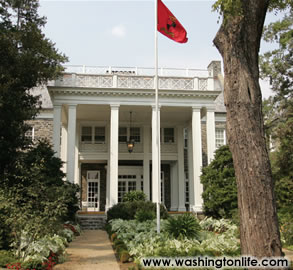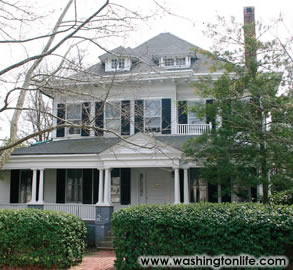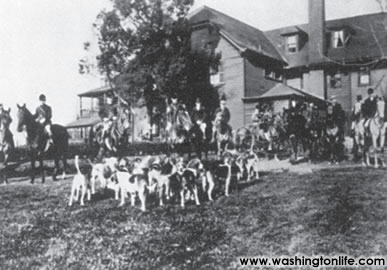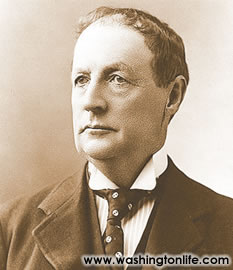|
The Ballad of Chevy Chase The short history of an ambitious plan to develop high-end real estate in the middle of nowhere
|
|||||||||||||||
 |
 |
| Top- The Chevy Chase Club / Above- One of the first 17 houses built in Chevy Chase Village. |
If you look at the grainy photos of Chevy Chase Circle when it was first plowed, you see a muddy road circling a treeless pasture far from anywhere Washingtonians wanted to live. But Senator Francis G. Newlands of Nevada had both the vision and the money to form the Chevy Chase Land Company and invest $1,250,000 (a fortune in 1893) to replace the empty fields around the circle with a community of expensive houses for the “leisure class,” far away from the then-fashionable Dupont Circle or Cleveland Park. Regrettably, his planned community did not come to full fruition until after he died. And, Sen. Newlands never knew that the hunt club he started as an afterthought would be one of the most prestigious country clubs in America.l
It all started in the 1700’s when a large tract of land around Western and Connecticut avenues was named “Chevy Chase” by its owner, Colonel Belt, who took the name from a 14th century ballad about the border wars between England and Scotland. In 1893, Newlands bought much of the Chevy Chase tract for his proposed development. He also bought a frame farmhouse that once belonged to Belt’s son to use as a venue for his friends to meet and fox hunt two or three times a week during the season.
The farmhouse was replaced in the early 1900’s by a new building, designed by a brilliant and aristocratic young architect, Jules Henry de Sibour. He had just finished creating a magnificent Beaux Arts palace at 1746 Massachusetts Avenue N.W., for Clarence Moore, a West Virginia coal magnate who was well known in society, a member of the best clubs in New York and Paris, and Master of the Hounds at the Chevy Chase Club. Moore was so impressed with de Sibour’s work that he invited him to design the new clubhouse.
 |
 |
| The Chevy Chase Hunt in front of their fi rst clubhouse, circa 1900 | Senator Francis G. Newlands, founder of the Chevy Chase Land Company, in 1903 |
After the clubhouse was finished, Moore decided to go shopping for foxhounds. In the spring of 1912, he went to the north of England, not far from the Cheviot Hills of the famous ballad, and purchased 25 brace of hounds. He sent the hounds back to the United States on one ship and then, unfortunately, booked his own passage on the maiden voyage of the Titanic. And the rest, as they say, is history.
The horses and hounds of the club soon seemed out of place in the growing residential area, and golf replaced the hunt as the club’s focus Exclusive and selective from the beginning by refusing to admit members “from trade or business,” the club also scared away many eligible Chevy Chase residents with the 1899 initiation fee of a whopping twenty five dollars. So for years its members were downtown people: moguls of society, statesmen, bankers, senators and presidents. To this day, the club’s members include those at the pinnacle of power and prestige. The biggest change has been the initiation fee, which is now $75,000!
What happened to Sen. Newland’s land development project? In the 1890’s, his guidelines stated that houses on Connecticut Avenue would have to cost at least $5,000 to build and those on the side streets at least $3,000. Now, these Chevy Chase Village homes range in price from $1 million to $4 million.
The Land Company continues to develop commercial projects on property it owns at the intersection of Wisconsin and Western. Newland’s million dollar land investment at the turn of the 19th century, then referred to by the family as “Uncle Frank’s Folly,” made his heirs wealthy for generations.
Clarence Moore’s beautiful house on Massachusetts Avenue, which he only occupied for a few years, is now the Embassy of Uzbekistan and still one of the best examples of Beaux Arts architecture in the city.
The prolific and talented Jules de Sibour left his mark on Washington as few others have, designing many graceful private homes and buildings from 1906 to the 1930’s, including the Jefferson Hotel and the building which now houses the National Trust for Historic Preservation. The French-born architect, a descendent of King Louis XI, was also a star at the great American game of baseball. He lent a lot of muscle to the team at the Chevy Chase Club, where he enjoyed many years of club membership and became a “regular”.
